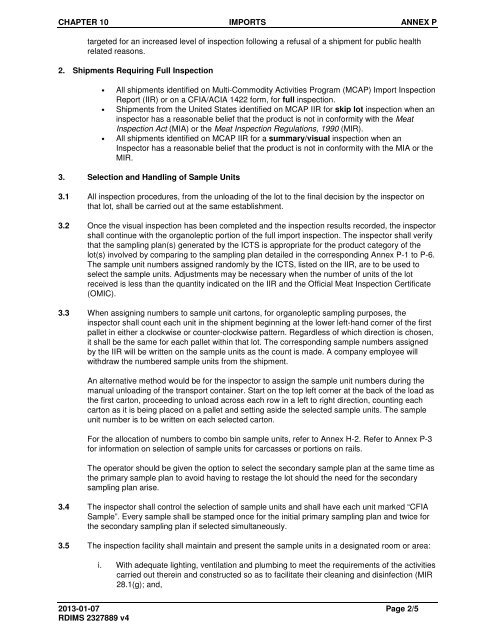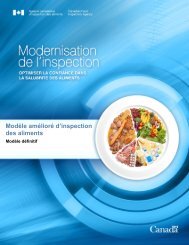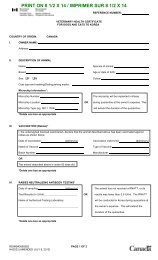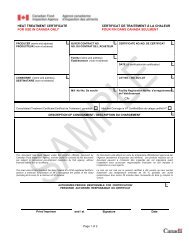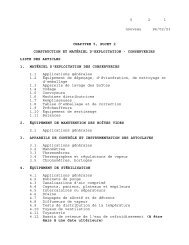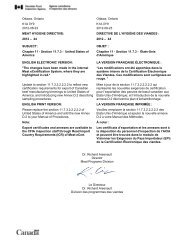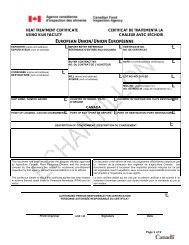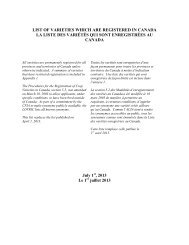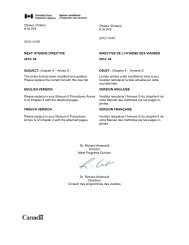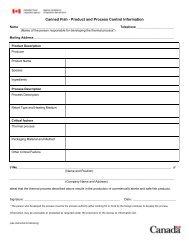PDF (342 kb ) - Agence canadienne d'inspection des aliments
PDF (342 kb ) - Agence canadienne d'inspection des aliments
PDF (342 kb ) - Agence canadienne d'inspection des aliments
You also want an ePaper? Increase the reach of your titles
YUMPU automatically turns print PDFs into web optimized ePapers that Google loves.
CHAPTER 10 IMPORTS ANNEX Ptargeted for an increased level of inspection following a refusal of a shipment for public healthrelated reasons.2. Shipments Requiring Full Inspection• All shipments identified on Multi-Commodity Activities Program (MCAP) Import InspectionReport (IIR) or on a CFIA/ACIA 1422 form, for full inspection.• Shipments from the United States identified on MCAP IIR for skip lot inspection when aninspector has a reasonable belief that the product is not in conformity with the MeatInspection Act (MIA) or the Meat Inspection Regulations, 1990 (MIR).• All shipments identified on MCAP IIR for a summary/visual inspection when anInspector has a reasonable belief that the product is not in conformity with the MIA or theMIR.3. Selection and Handling of Sample Units3.1 All inspection procedures, from the unloading of the lot to the final decision by the inspector onthat lot, shall be carried out at the same establishment.3.2 Once the visual inspection has been completed and the inspection results recorded, the inspectorshall continue with the organoleptic portion of the full import inspection. The inspector shall verifythat the sampling plan(s) generated by the ICTS is appropriate for the product category of thelot(s) involved by comparing to the sampling plan detailed in the corresponding Annex P-1 to P-6.The sample unit numbers assigned randomly by the ICTS, listed on the IIR, are to be used toselect the sample units. Adjustments may be necessary when the number of units of the lotreceived is less than the quantity indicated on the IIR and the Official Meat Inspection Certificate(OMIC).3.3 When assigning numbers to sample unit cartons, for organoleptic sampling purposes, theinspector shall count each unit in the shipment beginning at the lower left-hand corner of the firstpallet in either a clockwise or counter-clockwise pattern. Regardless of which direction is chosen,it shall be the same for each pallet within that lot. The corresponding sample numbers assignedby the IIR will be written on the sample units as the count is made. A company employee willwithdraw the numbered sample units from the shipment.An alternative method would be for the inspector to assign the sample unit numbers during themanual unloading of the transport container. Start on the top left corner at the back of the load asthe first carton, proceeding to unload across each row in a left to right direction, counting eachcarton as it is being placed on a pallet and setting aside the selected sample units. The sampleunit number is to be written on each selected carton.For the allocation of numbers to combo bin sample units, refer to Annex H-2. Refer to Annex P-3for information on selection of sample units for carcasses or portions on rails.The operator should be given the option to select the secondary sample plan at the same time asthe primary sample plan to avoid having to restage the lot should the need for the secondarysampling plan arise.3.4 The inspector shall control the selection of sample units and shall have each unit marked “CFIASample”. Every sample shall be stamped once for the initial primary sampling plan and twice forthe secondary sampling plan if selected simultaneously.3.5 The inspection facility shall maintain and present the sample units in a <strong>des</strong>ignated room or area:i. With adequate lighting, ventilation and plumbing to meet the requirements of the activitiescarried out therein and constructed so as to facilitate their cleaning and disinfection (MIR28.1(g); and,2013-01-07 Page 2/5RDIMS 2327889 v4


